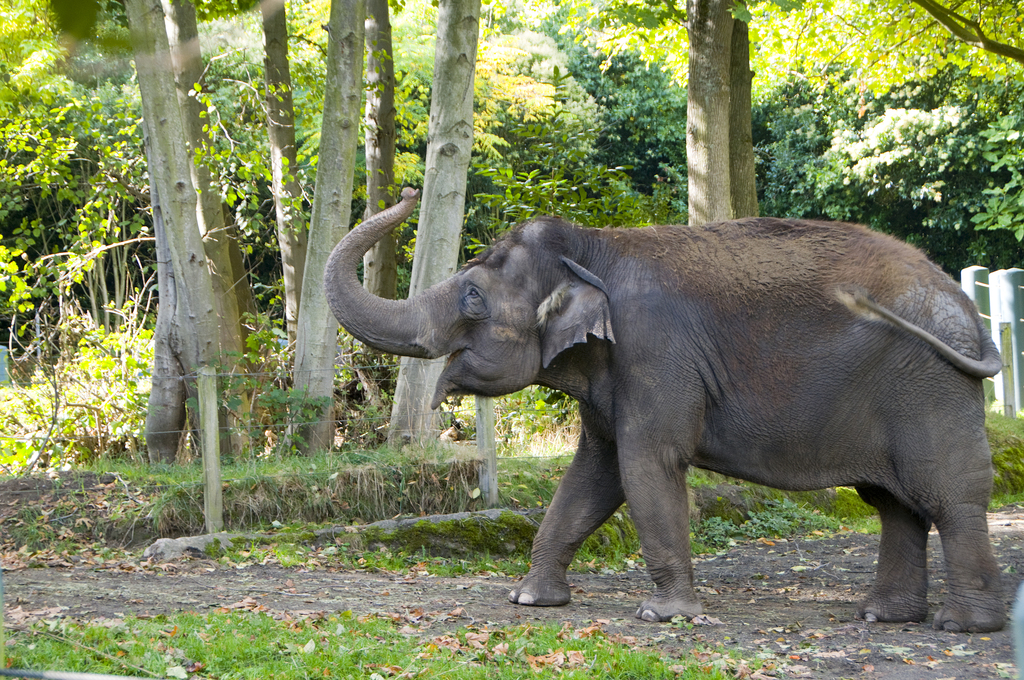
Statement on Elephant Care at Woodland Park Zoo
We want to continue to share this planet with elephants
Having elephants in zoos is crucial to maintaining the species. Most people will never experience an elephant in the wild, but we know that seeing, hearing, and experiencing these magnificent animals help all of us make an emotional connection, recognize the danger to their species, and act to stop the poaching and habitat loss that threaten their very existence. Conservation is the cornerstone of why we have elephants in zoos.
Recently, the Seattle Times published a two-part series on elephants in zoos. Woodland Park Zoo’s approach to elephant care and our attempt to help perpetuate the species by inseminating Chai, one of our Asian elephants, was highlighted in what we believe was a very biased and inaccurate slant. We would like to provide you with information that was not included in the series of stories.
The real story about the threat to elephants is not about the 305 elephants in American zoos. Elephants are facing increasingly deadly threats in their range countries. The illegal ivory trade and poaching for meat and hides is fueling large scale slaughter of thousands of elephants over the past decade. Loss of habitat due to human-elephant conflict is putting them at an even greater risk of extinction. These threats to the species were not covered in the Times’ series, nor was the vital role of zoos in educating the public, research, and preservation of the species.
Elephants in zoos directly benefit elephants in the wild by providing an invaluable source of information about their behavior, physiology, and physical and emotional needs. We have collaborated with field researchers to provide them with important data on elephant reproduction, communication and behavior that never could have been collected on wild populations.
While the Times story focused on instances of the elephant endotheliotropic herpesviruses (EEHV) that have killed animals in captivity, we now know that there are up to 50 documented cases of EEHV in wild Asian elephants. These are diseases we need to combat, for the sake of elephants in human care AND in the wild. We are making significant progress developing better diagnostics and new treatments for this suite of diseases. Scientific data show that all elephants have been carriers of the viruses for tens of millions of years.
Specifically about artificial insemination, the health and well-being of our animals is of utmost priority. Our elephant keepers have invested hours of training, over many years, preparing Chai for the 15-minute procedure. She is very comfortable in the chute. If there ever were a sign that she felt duress or discomfort, we would not proceed. At no time is Chai harmed, and we take our cues from her. She can choose to participate or not.
We want to reassure the larger community that we provide exemplary care for our elephants. We know them best, and respond to their changing needs every day. All three elephants at Woodland Park Zoo have healthy appetites, play, socialize, vocalize, and interact with each other, their environment, and with the zookeepers – signs they are healthy and happy. We invite everyone to come to the zoo to experience these magnificent animals for themselves.
The series was printed in the context of a national animal rights campaign protesting elephants in zoos, removing elephants from zoos, and sending them to privately owned and operated sanctuaries. Contrary to the second part of the series, we have no quarrel with sanctuaries. They are an appropriate solution for sick and dying elephants. They can provide refuge for elephants in need. Our elephants, however, do not fit this category.
Further, the stories characterized the elephants as “glamour beasts,” – necessary for the zoos’ bottom lines. Nothing could be further from the truth. Like most zoos, Woodland Park is a non-profit. Any money that comes in from admissions and other sources is used for operations. Any so-called “profits” are invested in the zoo and its animal population.
Not only for elephants, but for many other endangered species we have in our collection, zoos are part of the essential formula for saving animals, teaching families about serious threats such as climate change and habitat loss, and helping support and organize the field operations needed to keep them alive into the future.
Please find more information about our elephants and elephant care and conservation on our web page: www.zoo.org/elephants. If you have questions, please email: zooinfo@zoo.org.
Woodland Park Zoo CEO interview about elephants (KING 5, Dec. 5, 2012)
Elephants dying in epic frenzy as ivory fuels wars and profits (NY Times, Sept. 2012)
Blood Ivory (National Geographic, Oct. 2012)
Former AZA Director/William Conway Chair of Conservation & Science Discusses the State of Zoos & their Future (National Geographic NewsWatch, December 2012)
###
Woodland Park Zoo saves animals and their habitats through conservation leadership and engaging experiences, inspiring people to learn, care and act.
Photo Credit: Ryan Hawk/Woodland Park Zoo
NAIROBI, Kenya, 2024-Dec-30 — /Travel PR News/ — As the holiday season envelops us with warmth… Read More
DUBAI, 2024-Dec-29 — /Travel PR News/ — Luxota, a leader in travel technology solutions, is pleased… Read More
West Sussex, UK, 2024-Dec-29 — /Travel PR News/ — Sanctuary Spa Holidays, one of the world’s… Read More
Worcester, United States, 2024-Dec-29 — /Travel PR News/ — If your name is misspelled on… Read More
Chennai, India, 2024-Dec-29 — /Travel PR News/ — Mamallapuram is one of the most popular… Read More
NEW DELHI, 2024-Dec-29 — /Travel PR News/ — South Kerala, often referred to as “God’s… Read More
This website uses cookies.